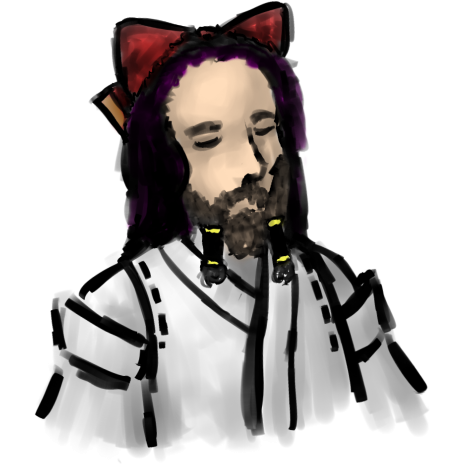- 📝 Posted:
- 🚚 Summary of:
- P0135, P0136
- ⌨ Commits:
a6eed55...252c13d,252c13d...07bfcf2- 💰 Funded by:
- [Anonymous]
- 🏷 Tags:
Alright, no more big code maintenance tasks that absolutely need to be
done right now. Time to really focus on parts 6 and 7 of repaying
technical debt, right? Except that we don't get to speed up just yet, as
TH05's barely decompilable PMD file loading function is rather…
complicated.
Fun fact: Whenever I see an unusual sequence of x86 instructions in PC-98
Touhou, I first consult the disassembly of Wolfenstein 3D. That game was
originally compiled with the quite similar Borland C++ 3.0, so it's quite
helpful to compare its ASM to the
officially released source
code. If I find the instructions in question, they mostly come from
that game's ASM code, leading to the amusing realization that "even John
Carmack was unable to get these instructions out of this compiler"
![]() This time though, Wolfenstein 3D did point me
to Borland's intrinsics for common C functions like
This time though, Wolfenstein 3D did point me
to Borland's intrinsics for common C functions like memcpy()
and strchr(), available via #pragma intrinsic.
Bu~t those unfortunately still generate worse code than what ZUN
micro-optimized here. Commenting how these sequences of instructions
should look in C is unfortunately all I could do here.
The conditional branches in this function did compile quite nicely
though, clarifying the control flow, and clearly exposing a ZUN
bug: TH05's snd_load() will hang in an infinite loop when
trying to load a non-existing -86 BGM file (with a .M2
extension) if the corresponding -26 BGM file (with a .M
extension) doesn't exist either.
Unsurprisingly, the PMD channel monitoring code in TH05's Music Room
remains undecompilable outside the two most "high-level" initialization
and rendering functions. And it's not because there's data in the
middle of the code segment – that would have actually been possible with
some #pragmas to ensure that the data and code segments have
the same name. As soon as the SI and DI registers are referenced
anywhere, Turbo C++ insists on emitting prolog code to save these
on the stack at the beginning of the function, and epilog code to restore
them from there before returning.
Found that out in
September 2019, and confirmed that there's no way around it. All the
small helper functions here are quite simply too optimized, throwing away
any concern for such safety measures. 🤷
Oh well, the two functions that were decompilable at least indicate
that I do try.
Within that same 6th push though, we've finally reached the one function in TH05 that was blocking further progress in TH04, allowing that game to finally catch up with the others in terms of separated translation units. Feels good to finally delete more of those .ASM files we've decompiled a while ago… finally!
But since that was just getting started, the most satisfying development
in both of these pushes actually came from some more experiments with
macros and inline functions for near-ASM code. By adding
"unused" dummy parameters for all relevant registers, the exact input
registers are made more explicit, which might help future port authors who
then maybe wouldn't have to look them up in an x86 instruction
reference quite as often. At its best, this even allows us to
declare certain functions with the __fastcall convention and
express their parameter lists as regular C, with no additional
pseudo-registers or macros required.
As for output registers, Turbo C++'s code generation turns out to be even
more amazing than previously thought when it comes to returning
pseudo-registers from inline functions. A nice example for
how this can improve readability can be found in this piece of TH02 code
for polling the PC-98 keyboard state using a BIOS interrupt:
inline uint8_t keygroup_sense(uint8_t group) {
_AL = group;
_AH = 0x04;
geninterrupt(0x18);
// This turns the output register of this BIOS call into the return value
// of this function. Surprisingly enough, this does *not* naively generate
// the `MOV AL, AH` instruction you might expect here!
return _AH;
}
void input_sense(void)
{
// As a result, this assignment becomes `_AH = _AH`, which Turbo C++
// never emits as such, giving us only the three instructions we need.
_AH = keygroup_sense(8);
// Whereas this one gives us the one additional `MOV BH, AH` instruction
// we'd expect, and nothing more.
_BH = keygroup_sense(7);
// And now it's obvious what both of these registers contain, from just
// the assignments above.
if(_BH & K7_ARROW_UP || _AH & K8_NUM_8) {
key_det |= INPUT_UP;
}
// […]
}
I love it. No inline assembly, as close to idiomatic C code as something
like this is going to get, yet still compiling into the minimum possible
number of x86 instructions on even a 1994 compiler. This is how I keep
this project interesting for myself during chores like these.
![]() We might have even reached peak
We might have even reached peak
inline already?
And that's 65% of technical debt in the SHARED segment repaid
so far. Next up: Two more of these, which might already complete that
segment? Finally!
